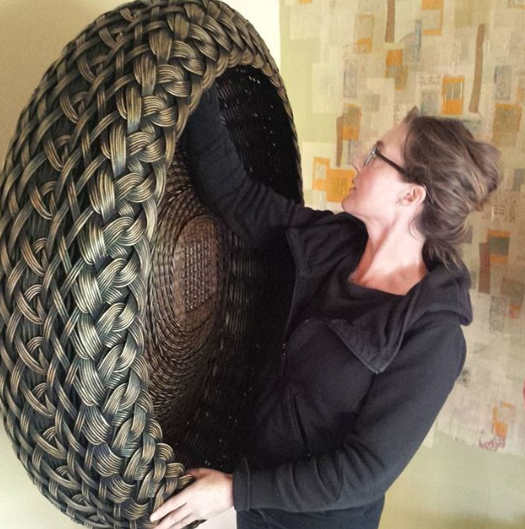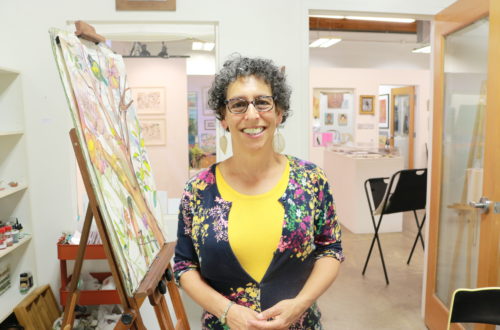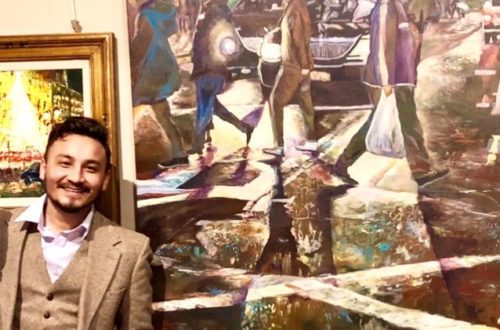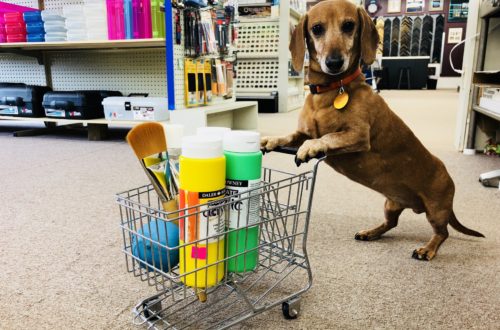During National Craft Month there is no better time to learn more about the history of craft and celebrate the artists who are continuing traditional crafts, resisting readymade culture by dedicating creative energy to form and function. These makers inspire us to think beyond the label “artist” or “craftsperson” and appreciate the essence of craft: to make something in a skillful way with our hands.
Peeta Tinay is an artist based in the Pacific Northwest whose love of weaving grew from her work with wicker furniture restoration. She began to teach basket-making and over the years built up her skills as a weaver; she creates large scale, stunning baskets, plaiting, lashing and twining reeds and adding a punch of color to her work with Jacquard Basic Dyes (another timely exploration, what with National Tie Dye Day coming up next month!).
Basketry 101
Basketry has a powerful history across cultures and continents. The practice of basket weaving involves transforming flexible plant fibers into containers used for storage, decoration, transport or ceremony. Traditionally, materials used for basketry are rooted in the region where the weaving takes place. A basket can be made out of various types of twigs, grass, bamboo, synthetic materials or recycled goods.
The style of basketry varies depending on material, tradition and aesthetic: coiled basketry uses soft, flexible grasses, while plaiting uses materials that are wide and flat for a braidlike effect (palms, yucca or flax). Twining basketry uses roots or tree bark for a criss cross technique while wicker basketry uses reed, cane, willow, oak or ash.
Peeta’s basketry technique combines twining, plaiting and lashing, depending on the project. She achieves fine details by starting with a small-diameter round reed and transitioning to larger reed as the basket grows in size. Amazed by her craftsmanship and her innovative use of Basic Dyes, we reached out to learn more about her process and motivation.

Centuries of Inspiration
What forms inspire you?
“Since I come from the restoration and the antique world, I’m inspired by all the pieces, all the techniques, all the looks. Antique baskets, fabric… it comes from all sources. Restoration can mean soaking an object, unweaving it, sometimes cutting entire sections away to recreate something that’s badly broken. And so I would see what’s underneath—the underlayer of weaving. You can see the early construction process, what someone was doing a hundred years ago, in the very early stages.”
How does this work suit you?
“Coming from the world of the restoration, I have a deep appreciation for things that are beautifully made. I enjoy the challenge of creating. Especially because I like to work big, it’s a real challenge to keep shape consistent. I’ve just found my groove with it. I’m slow to evolve: I’ll do something over and over and all of a sudden I’ll change something small. I like fine detail and then taking the fine detail and giving it big bold scale. It draws viewers in.“
You come from an artistic family. How did this impact your trajectory as a maker?
“I grew up with a narrative [around tools and making.] My grandfather was an inventor. He built all kinds of machines and people would come to him, say from a company who wanted a machine that would wrap candies. So he would invent a machine to do that. He didn’t have any education past high school; he was a hands on, skilled man. He passed by the time I came along, but going through his workshop there were tools, work benches, a small foundry. It was a mysterious place.”

The basket in process is dyed with black and brown Basic Dye, mixed to achieve the desired tone. Turquoise Basic Dye has been mixed as well to achieve the accent color.
Material & Technique
Where do you get your reed from?
“I use all the same materials that I used doing the repair work on those antique pieces. I get almost all my materials from direct importers, from the same plant, the vine rattan palm. There is round reed and flat reed. Then there is cane; that’s the bark of the rattan.”

What kind of techniques do you use?
“I do twining and plaiting. Plaiting is usually done with just one layer and requires a flat material. But I layer it; for instance, this with the purple and pink piece, not only does it have the Shibori dye technique on the outside pieces and the inside pieces of the flat reed; sandwiched in the middle are three pieces of quarter inch flat reed for a total of five layers. If you look straight on you see the shibori dyed flat reed but when you stand above it you can really see the layers. With the twining, in the basket base I use really small diameter number 2 round reed for my beginning weaving and then I transition out to larger diameters as the base grows in size so that generates additional interest, textural interest.”

Stunning Color with Jacquard Basic Dyes
Can you tell me more about how you use Jacquard Basic Dyes?
“The Jacquard Dyes are wonderful because they are so easy to use. It’s a single dye bath process with hot water. I don’t have to do anything to my materials other than get them ready for dying… I have to select materials for different density, certain pieces need to be stiffer or softer; but before the Basic Dyes I don’t have to do anything to my material, I just submerge them and weight them so everything gets evenly dyed.”

“I love the basic dyes because they are easy to use, they are quick and vibrant. I mix a lot of colors, I don’t typically use them out of the container. I build my own palette.”

How does this cool dye resist effect work?
“Ah, the Shibori dye technique! It was a happy discovery. A bundle of round reed in a dye bath lashed together with flat reed took on this “texture with color”. I thought, that’s so cool, how can I replicate that. I kept that piece for a long time. [Figuring it out] was a really intense process: I use quarter inch flat reed and as I’m going through the materials, I select the pieces that are best looking in terms of not having a lot of bend, they are very straight, then I cut the lengths I need (40 inch length). I sand them on both sides and I attach them to a large diameter PVC pipe, then I take a stretchy vinyl tape used for gardening, stretched and twisted, probably over 100 pieces in the pipe; before doing all that, I dyed it bright pink. I added the tape and made a purple dye bath in my over-sized cast iron bath. I kept an eye on the color and pulled them out when it was the deep purple I wanted.”

The Process
When you start a design, is there room for improvisation or do you stick to a plan?
“For the most part what I do is very structured, very planned out from the beginning. When I prepare the materials, it’s all very specific on what is going to happen. The type of weaving, the cut lengths. There is a piece that I just finished that had room for changing the way the top ended up curving in.”

What do you think about while you weave? What’s your environment like?
“It depends on which stage of the process I’m in: if I’m at a place where I know I really have to be mindful about shape and tension, a fine detailed part, I might have some music on, maybe. Maybe it’s quiet. With my finished work, I do a lot of sanding, re-dying before varnish and wax. When I get into the real physical weaving stages, it’s bigger, it’s more expressive because of the motion I’m doing—there is intense music going on.”
An assortment of Peeta’s tools
What are some things that your students are surprised by?
“That basket weaving is physically hard. Unless you do this all the time and you know how to move your hands, your skin gets raw, you get blisters. They are also surprised by how hard they have to work to hold things in place.The way I shape allows for a consistent, beautiful, tightly woven basket. People who have woven for a long time often find that my technique is helpful for achieving more consistency. They have a light bulb moment.”
What crafts are you learning about this month? Any light bulb moments of your own? Are any of your customers fiber artists? How does your community use Basic Dyes? Let us know in the comments or email us at artdogblog (@) macphersonart.com.







2 Comments
Lynn McGuire
I loved your article. I’m one of Peeta’s students. When I took my first class from her I had no idea what a wonderful artist she is.
She is an extremely patient person. Supportive of the most humble efforts, generous with her advice and just a joy to spend time with.
Catherine Monahon, Copywriter • MacPherson's
Lynn, thanks so much for your comment! I learned so much from Peeta, and that was only from one conversation. Basket-weaving is a fascinating art that takes such discipline and commitment. Thanks for sharing your experience and checking out Art Dog.